Relaxation Techniques for Anxiety: Finding Inner Peace
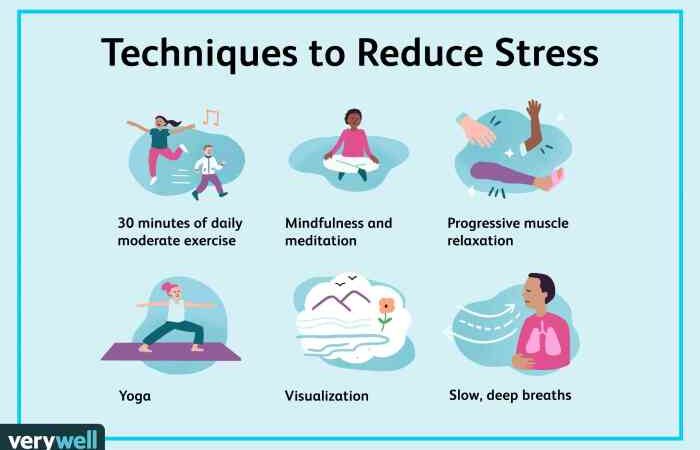
Relaxation techniques for anxiety offer a powerful path to managing stress and promoting well-being. Anxiety, a common human experience, can manifest in various ways, from racing thoughts to physical symptoms like rapid heartbeat and shortness of breath. By understanding the root causes of anxiety and exploring effective relaxation strategies, individuals can empower themselves to navigate challenges and cultivate a sense of calm amidst life’s demands.
This comprehensive guide delves into a range of techniques, from deep breathing exercises and mindfulness practices to physical activity and cognitive behavioral therapy. Each approach provides valuable tools for managing anxiety, allowing individuals to personalize their journey toward inner peace and resilience.
Understanding Anxiety and Relaxation
Anxiety is a common human experience that can manifest in various ways. It is a natural stress response and can help motivate us to take action or avoid danger. However, when anxiety becomes excessive or persistent, it can interfere with our daily lives and well-being.
The Physiological and Psychological Effects of Anxiety
Anxiety can trigger a cascade of physical and emotional responses. When we perceive a threat, our body releases hormones like adrenaline and cortisol, preparing us for a “fight-or-flight” response. This physiological response can lead to various physical symptoms such as:
- Increased heart rate
- Rapid breathing
- Muscle tension
- Sweating
- Nausea
- Dizziness
- Trembling
Beyond physical changes, anxiety can also have significant psychological effects. Common psychological symptoms include:
- Worry
- Fear
- Restlessness
- Difficulty concentrating
- Irritability
- Insomnia
- Feeling overwhelmed
The Connection Between Anxiety and Stress
Anxiety and stress are closely intertwined. Stress is a natural response to challenging situations, and it can trigger anxiety. Conversely, anxiety can also exacerbate stress levels, creating a vicious cycle.
“Stress is a normal psychological and physical response to a demanding situation. Anxiety is a more intense, longer-lasting, and often disproportionate response to a perceived threat.”
For example, if you are preparing for a big presentation, you might experience stress. This stress can lead to anxiety, causing you to worry excessively, have difficulty concentrating, or feel physically tense. This anxiety, in turn, can further increase your stress levels, making it harder to prepare for the presentation effectively.
Examples of Common Anxiety Symptoms
Anxiety can manifest in a variety of ways, and the symptoms can vary from person to person. Some common examples of anxiety symptoms include:
- Panic attacks: Sudden episodes of intense fear that involve physical symptoms like rapid heart rate, sweating, dizziness, and shortness of breath. These attacks can be very frightening and often lead to a fear of having another attack.
- Generalized anxiety disorder (GAD): Persistent and excessive worry about various things, often accompanied by physical symptoms like muscle tension, fatigue, and difficulty sleeping.
- Social anxiety disorder: Intense fear and anxiety in social situations, often leading to avoidance of social gatherings or interactions.
- Phobias: Irrational and intense fear of specific objects or situations, such as spiders, heights, or public speaking.
- Obsessive-compulsive disorder (OCD): Recurring thoughts (obsessions) that cause anxiety, leading to repetitive behaviors (compulsions) aimed at reducing the anxiety.
Deep Breathing Techniques
Deep breathing techniques are powerful tools for managing anxiety. They work by slowing your heart rate, lowering your blood pressure, and calming your nervous system. When you breathe deeply, you send a signal to your brain that you are safe and relaxed.
This can help to reduce feelings of anxiety and stress.
Diaphragmatic Breathing
Diaphragmatic breathing, also known as belly breathing, is a simple yet effective technique that focuses on using your diaphragm, the large muscle below your lungs, to take deep breaths. Here are the benefits of diaphragmatic breathing:* Reduces anxiety and stress: Deep breaths trigger the relaxation response, reducing stress hormones and promoting calmness.
Improves sleep quality
By calming the nervous system, diaphragmatic breathing can help you fall asleep faster and sleep more soundly.
Increases lung capacity
This technique helps you use your lungs more efficiently, increasing your oxygen intake.
Reduces muscle tension
By promoting relaxation, it can alleviate muscle tension associated with anxiety. Here is a step-by-step guide for practicing diaphragmatic breathing:
1. Find a comfortable position
Sit or lie down in a relaxed position.
2. Place one hand on your chest and the other on your stomach
You should feel your stomach rise as you inhale and fall as you exhale.
3. Inhale slowly and deeply through your nose
Focus on expanding your stomach as you breathe in.
4. Exhale slowly through your mouth
Allow your stomach to deflate as you breathe out.
5. Repeat steps 3 and 4 for 5-10 minutes
Focus on your breath and let go of any distracting thoughts.
Box Breathing
Box breathing is a technique that involves breathing in a specific pattern, creating a box shape on a graph of your breath. This technique is often used by military personnel to manage stress and improve focus. Here are the benefits of box breathing:
Reduces anxiety and stress: By slowing down your breathing and creating a rhythmic pattern, it helps calm your nervous system.
Improves focus and concentration
The structured breathing pattern can help you stay present and focused.
Promotes relaxation and mindfulness
The focus on your breath can help you become more aware of your body and the present moment. Here is a step-by-step guide for practicing box breathing:
1. Find a comfortable position
Sit or lie down in a relaxed position.
2. Inhale slowly and deeply through your nose
Count to 4 as you inhale.
3. Hold your breath
Count to 4 as you hold your breath.
4. Exhale slowly through your mouth
Count to 4 as you exhale.
5. Hold your breath
Count to 4 as you hold your breath.
6. Repeat steps 2-5 for 5-10 minutes
Focus on the rhythm of your breath and let go of any distracting thoughts.
Mindfulness and Meditation
Mindfulness and meditation are powerful techniques that can help you manage anxiety and promote overall well-being. These practices involve focusing your attention on the present moment, without judgment, and observing your thoughts, feelings, and sensations with a sense of acceptance.
Mindfulness Practices for Managing Anxiety
Mindfulness practices can help you manage anxious thoughts by:
- Increasing awareness of your thoughts: Mindfulness helps you observe your thoughts without getting caught up in them. This allows you to identify anxious thoughts as they arise and recognize them as just thoughts, not necessarily facts.
- Reducing rumination: When you practice mindfulness, you become more present in the moment, reducing the tendency to dwell on past worries or future anxieties. This can help you break free from negative thought patterns.
- Developing emotional regulation skills: Mindfulness helps you observe your emotions without judgment. This allows you to understand and accept your feelings, even difficult ones, without getting overwhelmed.
- Promoting self-compassion: Mindfulness encourages kindness and acceptance toward yourself, which can be particularly helpful when dealing with anxiety. By practicing self-compassion, you can lessen the impact of negative self-talk and build resilience.
Types of Meditation
Meditation encompasses a wide range of practices. Here’s a table comparing some common types:
| Type of Meditation | Description | Benefits for Anxiety |
|---|---|---|
| Guided Meditation | A guided meditation involves listening to an instructor’s voice leading you through a series of instructions and visualizations. | Guided meditations can help you focus your attention, reduce racing thoughts, and promote relaxation. |
| Progressive Relaxation | Progressive relaxation involves systematically tensing and relaxing different muscle groups in your body. | This technique can help you release physical tension associated with anxiety and promote a sense of calm. |
| Mindful Breathing | Mindful breathing involves paying attention to your breath as it enters and leaves your body. | Focusing on your breath can help you anchor your attention in the present moment, reducing anxiety and promoting relaxation. |
| Transcendental Meditation | Transcendental Meditation involves repeating a mantra silently to yourself for a specific period. | This practice can help reduce stress, improve focus, and promote inner peace. |
| Loving-Kindness Meditation | Loving-kindness meditation involves cultivating feelings of compassion and kindness toward yourself and others. | This type of meditation can help reduce anxiety by promoting feelings of connection and reducing isolation. |
Physical Activity and Relaxation: Relaxation Techniques For Anxiety
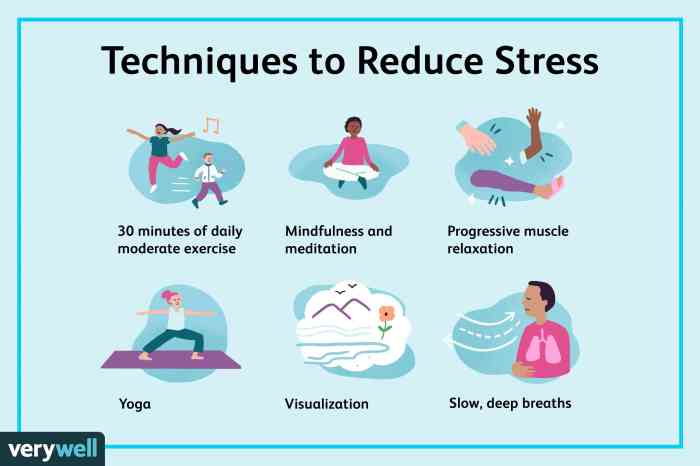
Physical activity plays a crucial role in reducing anxiety and promoting overall well-being. Engaging in regular exercise can help manage stress hormones, improve mood, and enhance cognitive function, leading to a calmer and more balanced state of mind.
Types of Physical Activities and Their Benefits
Different types of physical activities offer unique benefits for managing anxiety. Here are some examples:
- Yoga: This ancient practice combines physical postures, breathing techniques, and meditation. Yoga helps to increase flexibility, reduce muscle tension, and promote relaxation. It also improves focus and concentration, which can be beneficial for managing anxiety.
- Tai Chi: This gentle form of exercise involves slow, flowing movements and deep breathing. Tai Chi helps to reduce stress, improve balance, and enhance coordination. Its focus on mindfulness and gentle movements makes it a suitable option for individuals with anxiety.
- Walking: A simple yet effective form of exercise, walking can provide a sense of calm and release endorphins, which have mood-boosting effects. Regular walking can also help to improve sleep quality, which is often disrupted by anxiety.
Incorporating Exercise into a Daily Routine
Incorporating physical activity into a daily routine can be challenging, but it’s essential for managing anxiety. Here are some tips for making exercise a regular habit:
- Start Small: Begin with short sessions of exercise and gradually increase the duration and intensity. Even a few minutes of activity can make a difference.
- Find Activities You Enjoy: Choose activities that you find enjoyable and motivating. This will make it more likely that you’ll stick to your exercise routine.
- Schedule Exercise Time: Treat exercise as an important appointment and schedule it into your daily routine. This will help you prioritize physical activity.
- Find a Workout Buddy: Exercising with a friend can provide support and motivation. It can also make exercise more enjoyable.
Progressive Muscle Relaxation
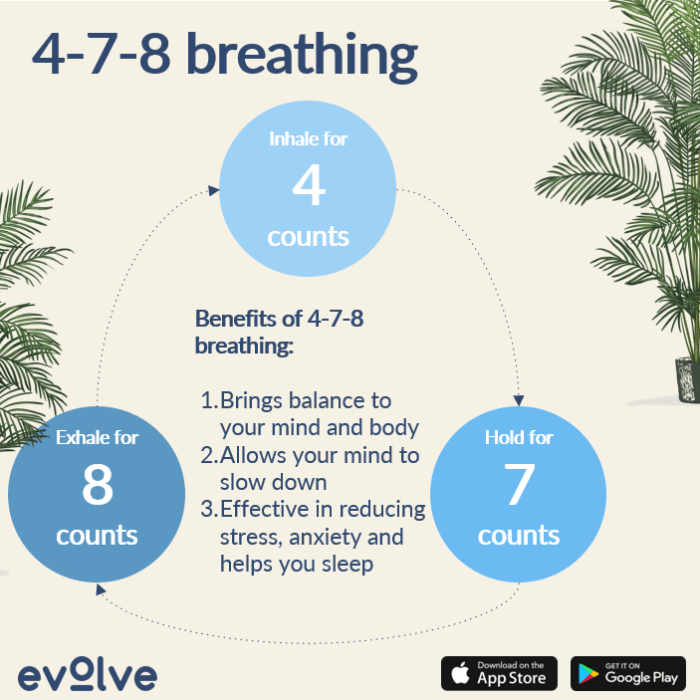
Progressive muscle relaxation is a technique that involves tensing and relaxing different muscle groups in the body. By becoming aware of the difference between tension and relaxation, individuals can learn to release physical tension and reduce anxiety.
Steps Involved in Progressive Muscle Relaxation
Progressive muscle relaxation involves systematically tensing and relaxing different muscle groups throughout the body. This process helps individuals become more aware of physical tension and develop the ability to release it. Here are the steps involved:
- Find a quiet and comfortable place where you can lie down or sit comfortably.
- Begin by focusing on your breathing, and taking slow and deep breaths. This helps to calm your mind and body.
- Start with your right hand. Make a tight fist, squeezing as hard as you can for 5 seconds. Notice the tension in your hand and forearm.
- Release the tension in your hand and let your arm go limp. Notice the difference between tension and relaxation.
- Repeat this process for each muscle group, moving progressively up your body.
- Focus on your left hand, then your right bicep, left bicep, forehead, eyes, jaw, neck, shoulders, chest, back, stomach, right thigh, left thigh, right calf, left calf, and finally your right and left foot.
- As you move through each muscle group, pay attention to the sensations of tension and relaxation. Notice the difference between the two states.
- Once you have completed all the muscle groups, take a few moments to simply relax and enjoy the feeling of relaxation throughout your body.
How Progressive Muscle Relaxation Helps Relieve Tension and Anxiety
Progressive muscle relaxation works by reducing physical tension, which can significantly contribute to anxiety. By tensing and then relaxing specific muscle groups, individuals become more aware of the sensations of tension and relaxation. This heightened awareness allows them to recognize and release physical tension, which in turn reduces anxiety levels.
- Reduces Physical Tension: By consciously tensing and relaxing muscles, individuals become more aware of physical tension and learn to release it. This reduces overall muscle tension and promotes a sense of relaxation.
- Promotes Relaxation: The process of tensing and relaxing muscles triggers the body’s relaxation response, which counteracts the “fight-or-flight” response associated with anxiety. This leads to a feeling of calm and relaxation.
- Improves Sleep Quality: By reducing physical tension and promoting relaxation, progressive muscle relaxation can improve sleep quality. This is because anxiety and muscle tension can interfere with sleep patterns.
- Reduces Stress Hormones: When individuals are stressed, their bodies release stress hormones like cortisol. Progressive muscle relaxation can help reduce the production of these hormones, leading to a more relaxed state.
Muscle Groups Targeted in Progressive Muscle Relaxation
| Muscle Group | Action |
|---|---|
| Right Hand | Make a tight fist |
| Left Hand | Make a tight fist |
| Right Bicep | Bend your arm at the elbow and tense your bicep |
| Left Bicep | Bend your arm at the elbow and tense your bicep |
| Forehead | Raise your eyebrows as high as possible |
| Eyes | Close your eyes tightly |
| Jaw | Clench your jaw tightly |
| Neck | Tilt your head back and tense your neck muscles |
| Shoulders | Shrug your shoulders up to your ears |
| Chest | Take a deep breath and hold it, tightening your chest muscles |
| Back | Arch your back and tense your back muscles |
| Stomach | Tighten your stomach muscles as if you were preparing for a punch |
| Right Thigh | Straighten your leg and tense your thigh muscles |
| Left Thigh | Straighten your leg and tense your thigh muscles |
| Right Calf | Point your toes and tense your calf muscles |
| Left Calf | Point your toes and tense your calf muscles |
| Right Foot | Curl your toes and tense your foot muscles |
| Left Foot | Curl your toes and tense your foot muscles |
Cognitive Behavioral Therapy (CBT) Techniques
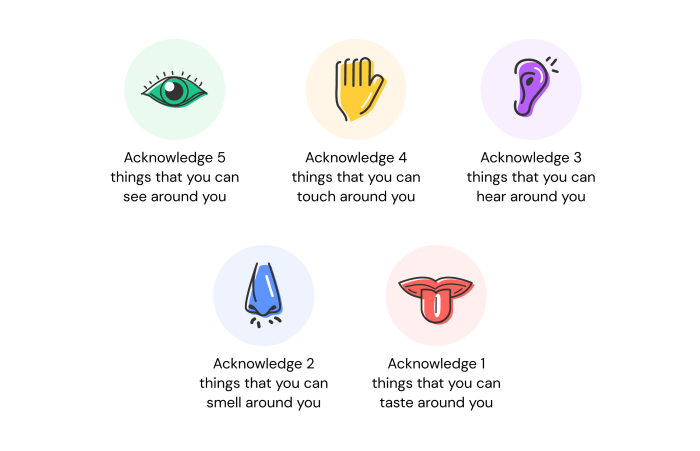
Cognitive Behavioral Therapy (CBT) is a widely used and effective therapy for managing anxiety. It focuses on identifying and changing negative thought patterns and behaviors that contribute to anxiety. CBT helps individuals develop coping mechanisms and strategies to manage their anxiety in various situations.
Challenging Negative Thoughts
Negative thoughts can significantly amplify anxiety. CBT helps individuals identify and challenge these negative thoughts by examining their validity and replacing them with more balanced and realistic perspectives. This process involves:
- Identifying Negative Thoughts: Becoming aware of the recurring negative thoughts that trigger anxiety.
- Evaluating the Evidence: Examining the evidence that supports or contradicts the negative thought. This involves asking questions like, “Is there any real evidence to support this thought?” or “What is the likelihood of this thought being true?”
- Developing Alternative Thoughts: Replacing negative thoughts with more balanced and realistic alternatives. This involves considering different perspectives and challenging the negativity bias.
For example, if someone with social anxiety experiences a negative thought like “Everyone is judging me,” CBT can help them challenge this thought by asking themselves, “Is there any evidence that everyone is judging me?” or “What are the chances that everyone is focused on me?” They can then replace the negative thought with a more realistic one like, “It’s unlikely that everyone is focused on me, and even if some people are, it doesn’t mean they are judging me negatively.”
Exposure Therapy
Exposure therapy is a CBT technique that involves gradually exposing individuals to anxiety-provoking situations in a safe and controlled environment. This helps them learn to cope with their anxiety and reduce their fear response over time.
- Gradual Exposure: Starting with less anxiety-provoking situations and gradually increasing the intensity of exposure.
- Controlled Environment: Conducting exposure therapy in a safe and supportive setting, often with the guidance of a therapist.
- Managing Anxiety: Utilizing coping mechanisms and relaxation techniques to manage anxiety during exposure.
For instance, someone with a fear of public speaking might start by practicing their speech in front of a mirror, then progress to speaking in front of a small group of friends, and eventually work up to speaking in front of a larger audience.
Implementing CBT Techniques in Everyday Life
Implementing CBT techniques in everyday life requires consistent effort and practice. Here’s a guide on how to integrate CBT into your daily routine:
- Identify Your Triggers: Pay attention to situations or thoughts that trigger your anxiety. Keep a journal to track your anxiety levels and identify patterns.
- Challenge Negative Thoughts: When you experience a negative thought, challenge it by asking yourself if it’s true, if there’s any evidence to support it, and if there are alternative perspectives. Replace the negative thought with a more balanced one.
- Practice Relaxation Techniques: Incorporate relaxation techniques like deep breathing, mindfulness, or progressive muscle relaxation into your daily routine to manage anxiety and promote calmness.
- Expose Yourself Gradually: Gradually expose yourself to situations that trigger your anxiety in a safe and controlled environment. Start small and work your way up to more challenging situations.
- Seek Professional Help: If you’re struggling to manage your anxiety on your own, consider seeking professional help from a therapist specializing in CBT.
Relaxation Techniques for Specific Situations

Anxiety can be triggered by specific situations, making it essential to learn relaxation techniques tailored to these triggers. By identifying and addressing these triggers, you can manage anxiety effectively and enhance your overall well-being.
Relaxation Techniques for Public Speaking
Public speaking is a common anxiety trigger for many individuals. The fear of judgment, scrutiny, and potential embarrassment can lead to significant anxiety. However, several relaxation techniques can help manage this anxiety:
- Deep Breathing Exercises: Before your speech, practice deep, slow breaths to calm your nervous system. Inhale deeply through your nose, hold for a few seconds, and exhale slowly through your mouth. This technique can help regulate your heart rate and reduce physical symptoms of anxiety.
- Visualization: Imagine yourself delivering a successful speech, engaging with the audience, and receiving positive feedback. Visualizing a positive outcome can boost your confidence and reduce anxiety.
- Positive Self-Talk: Replace negative thoughts with positive affirmations. Remind yourself of your strengths, your preparation, and your ability to communicate effectively. This can help shift your focus from anxiety to confidence.
Relaxation Techniques for Social Situations
Social situations can be challenging for individuals with social anxiety. The fear of being judged, rejected, or appearing awkward can trigger anxiety. Here are some relaxation techniques for managing anxiety in social settings:
- Mindfulness Meditation: Focus on the present moment, paying attention to your senses and thoughts without judgment. This practice can help reduce overthinking and create a sense of calm and awareness.
- Progressive Muscle Relaxation: Tense and release different muscle groups in your body, starting from your toes and working your way up. This technique can help release physical tension associated with anxiety.
- Social Skills Training: Enhance your social skills through training programs or workshops. Learning effective communication techniques, social cues, and assertive behaviors can build confidence and reduce anxiety in social situations.
Relaxation Techniques for Work
Work-related anxiety can stem from demanding deadlines, challenging tasks, and interpersonal conflicts. To manage this anxiety, consider these techniques:
- Time Management: Prioritize tasks, set realistic deadlines, and break down large projects into smaller, manageable steps. Effective time management can reduce stress and anxiety.
- Stress-Reducing Activities: Engage in activities that help you de-stress, such as taking breaks, listening to music, or spending time in nature. These activities can provide a mental and emotional respite from work-related pressures.
- Workplace Mindfulness: Incorporate mindfulness practices into your workday, such as taking short breaks to focus on your breath or engaging in a mindful walk. This can help improve focus, reduce stress, and enhance productivity.
Relaxation Techniques for School
Academic pressures, social interactions, and the fear of failure can contribute to anxiety in school. Here are some relaxation techniques for managing school-related anxiety:
- Study Skills: Develop effective study habits, including time management, organization, and active learning techniques. This can reduce stress and anxiety associated with academic performance.
- Mindful Breathing: Practice deep breathing exercises before exams or presentations to calm your nervous system and improve focus. This can help manage anxiety and enhance performance.
- Peer Support: Connect with classmates or study groups for support and encouragement. Sharing experiences and strategies can reduce feelings of isolation and anxiety.
Relaxation Techniques for Various Anxiety-Inducing Situations
| Situation | Relaxation Techniques ||—|—|| Public Speaking | Deep breathing exercises, visualization, positive self-talk || Social Situations | Mindfulness meditation, progressive muscle relaxation, social skills training || Work | Time management, stress-reducing activities, workplace mindfulness || School | Study skills, mindful breathing, peer support || Travel | Packing light, planning ahead, deep breathing exercises || Medical Appointments | Mindfulness meditation, distraction techniques, positive self-talk || Financial Concerns | Budgeting, financial planning, relaxation techniques || Relationship Conflicts | Communication skills, active listening, compromise || Job Interviews | Practice answering common questions, visualization, deep breathing exercises |
Lifestyle Modifications for Relaxation
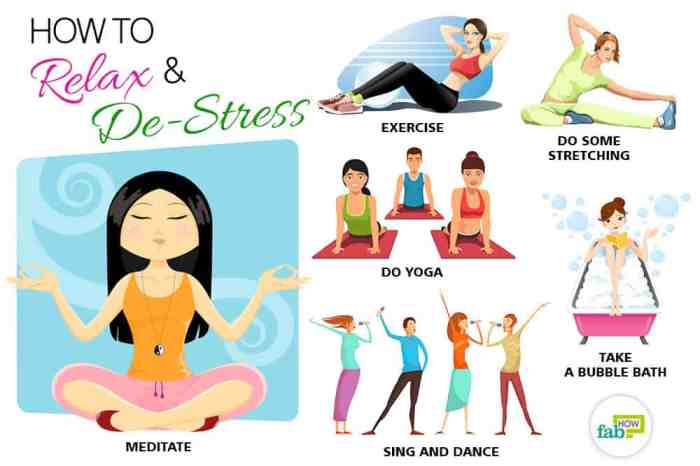
Incorporating lifestyle modifications into your daily routine can significantly contribute to your overall well-being and help manage anxiety. By creating a relaxing environment, prioritizing sleep, and incorporating relaxation activities, you can cultivate a sense of calm and reduce stress levels.
Creating a Relaxing Home Environment
Your home should be a sanctuary where you can unwind and de-stress. Creating a relaxing environment can promote feelings of peace and tranquility, reducing the impact of anxiety.
- Minimize Clutter: A cluttered space can create feelings of overwhelm and anxiety. Regularly declutter your home to create a sense of order and calm.
- Incorporate Natural Elements: Bringing nature indoors can promote relaxation. Incorporate plants, natural light, and earthy tones into your decor to create a calming ambiance.
- Use Soothing Colors: Soft, muted colors like blues, greens, and purples can have a calming effect on the mind and body.
- Create a Designated Relaxation Space: Designate a specific area in your home as a relaxation zone. This could be a comfortable chair, a cozy corner, or a meditation room.
- Use Aromatherapy: Certain scents, such as lavender, chamomile, and sandalwood, are known to promote relaxation and reduce stress.
- Play Soothing Music: Classical music, nature sounds, or calming instrumental music can create a peaceful atmosphere.
Sleep Hygiene for Anxiety Management
Adequate sleep is crucial for both physical and mental health. Poor sleep can exacerbate anxiety symptoms, while good sleep hygiene can help manage anxiety levels.
- Establish a Regular Sleep Schedule: Go to bed and wake up at the same time each day, even on weekends, to regulate your body’s natural sleep-wake cycle.
- Create a Relaxing Bedtime Routine: Wind down an hour or two before bed by engaging in calming activities like taking a warm bath, reading a book, or listening to relaxing music.
- Optimize Your Sleep Environment: Ensure your bedroom is dark, quiet, and cool. Use blackout curtains, earplugs, or a white noise machine to block out distractions.
- Avoid Caffeine and Alcohol Before Bed: These substances can interfere with sleep quality.
- Get Regular Exercise: Physical activity can improve sleep quality, but avoid exercising too close to bedtime.
- Limit Screen Time Before Bed: The blue light emitted from electronic devices can suppress melatonin production, making it harder to fall asleep.
Incorporating Relaxation Activities into Daily Routine, Relaxation techniques for anxiety
Regularly engaging in relaxation activities can help manage anxiety and promote overall well-being. It’s important to find activities that you enjoy and that work for your lifestyle.
- Mindfulness Meditation: Mindfulness meditation involves focusing on the present moment without judgment. It can help reduce stress, improve focus, and increase self-awareness.
- Yoga and Tai Chi: These practices combine physical movement with mindfulness, promoting relaxation, flexibility, and stress reduction.
- Deep Breathing Exercises: Deep breathing techniques, such as diaphragmatic breathing, can help calm the nervous system and reduce anxiety symptoms.
- Progressive Muscle Relaxation: This technique involves tensing and relaxing different muscle groups in the body to promote relaxation and reduce tension.
- Spending Time in Nature: Spending time outdoors in nature can have a calming effect on the mind and body.
- Engaging in Hobbies: Pursuing hobbies you enjoy can provide a sense of accomplishment, reduce stress, and promote relaxation.
- Spending Time with Loved Ones: Social connection can provide support and reduce feelings of isolation, which can exacerbate anxiety.
Seeking Professional Help
While relaxation techniques can be incredibly helpful in managing anxiety, it’s important to understand that they are not a replacement for professional help. Sometimes, anxiety can be so severe or persistent that it significantly impacts your daily life. In these cases, seeking professional help is crucial.
When to Seek Professional Help
Seeking professional help for anxiety is essential when it interferes with your ability to function in daily life. This could include experiencing significant distress, difficulty concentrating, avoiding social situations, or experiencing physical symptoms like rapid heartbeat or difficulty breathing. Additionally, if you have thoughts of harming yourself or others, it’s crucial to seek immediate professional help.
Types of Therapy for Anxiety Disorders
Several types of therapy can be effective in treating anxiety disorders. These therapies work by helping you understand and manage your anxiety, develop coping skills, and change negative thought patterns.
Cognitive Behavioral Therapy (CBT)
CBT is a widely used therapy that focuses on identifying and changing negative thoughts and behaviors that contribute to anxiety. It involves working with a therapist to identify your anxiety triggers, challenge irrational thoughts, and develop healthier coping mechanisms.
Exposure Therapy
Exposure therapy involves gradually confronting your fears and anxieties in a safe and controlled environment. This helps you to learn that your fears are often unfounded and that you can manage them effectively.
Mindfulness-Based Therapy
Mindfulness-based therapies, such as Mindfulness-Based Stress Reduction (MBSR), teach you to focus on the present moment without judgment. This can help you to reduce anxiety by becoming more aware of your thoughts and feelings without getting caught up in them.
Psychodynamic Therapy
Psychodynamic therapy explores the underlying psychological factors that contribute to anxiety. It focuses on identifying and understanding past experiences and how they may be affecting your current anxiety.
The Role of Medication in Managing Anxiety
Medication can be a helpful tool for managing anxiety, especially in severe cases. Anti-anxiety medications, such as benzodiazepines, can help to reduce anxiety symptoms quickly, but they are typically used for short-term relief. Antidepressants, such as selective serotonin reuptake inhibitors (SSRIs), are often used for long-term management of anxiety disorders.
It’s important to note that medication should always be used under the guidance of a qualified healthcare professional.
It’s important to remember that seeking professional help is a sign of strength, not weakness. By taking proactive steps to address your anxiety, you can improve your overall well-being and quality of life.
Wrap-Up
The journey toward managing anxiety is a personal one, and finding the right combination of relaxation techniques can make a world of difference. By incorporating these strategies into daily life, individuals can cultivate a greater sense of control, reduce stress, and enhance their overall well-being.
Remember, seeking professional guidance from a therapist or counselor can provide personalized support and address underlying issues contributing to anxiety.
Comments are closed.